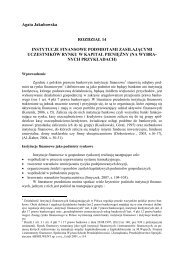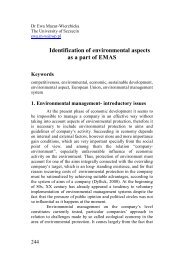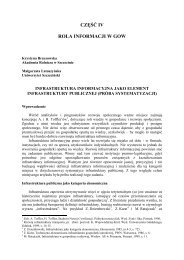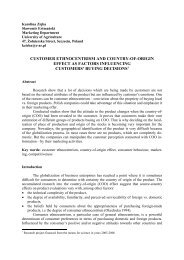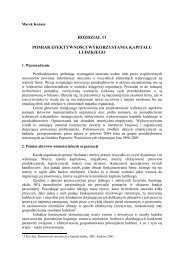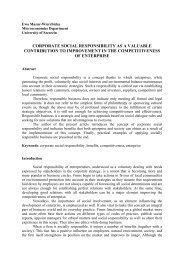Concepts of Strong Comparability and Commensurability versus ...
Concepts of Strong Comparability and Commensurability versus ...
Concepts of Strong Comparability and Commensurability versus ...
You also want an ePaper? Increase the reach of your titles
YUMPU automatically turns print PDFs into web optimized ePapers that Google loves.
When we speak about “weak” <strong>and</strong> “strong” sustainability, it<br />
must be noticed, that “weak” sustainability with its narrow version <strong>of</strong><br />
sustainability started to use, when it was noticed that “strong”<br />
sustainability is impossible to use in practice. Tietenberg (1984)<br />
defined sustainability as “relentless utility”. Then, applying the<br />
concept <strong>of</strong> “weak” sustainability, sustainability might denote<br />
securing people’s welfare in order it could thrive or at least would<br />
remain stable. Considering such interpretation <strong>of</strong> sustainability, it<br />
equals the prerequisite to ensure people’s wealth not to decrease in<br />
the period <strong>of</strong> time.<br />
As <strong>of</strong> today, all these debates about weak sustainability tend to<br />
focus on increasing the stock <strong>of</strong> man-made capital <strong>and</strong> the degree to<br />
which other capital stocks maybe reduced for this behalf (OECD,<br />
2001). As shown by Spangenberg (2005), in other words, sustained<br />
growth is – <strong>of</strong>ten implicitly – assumed to be part <strong>of</strong> the concept <strong>of</strong><br />
sustainable development <strong>of</strong> the economy by most authors, <strong>and</strong> only<br />
small fraction <strong>of</strong> ecological economists disagrees. On other h<strong>and</strong>,<br />
substitution between different capital stocks as discussed by<br />
economists mainly refers to the function <strong>of</strong> these capitals as<br />
production factors. If under changing factor constellations the<br />
product is equivalent (<strong>of</strong>ten in monetary terms), substitution is<br />
considered possible. Unfortunately, this analysis refers only to one<br />
criterion; utility production measured in monetary terms, <strong>and</strong><br />
completely neglects all other aspects <strong>of</strong> the economic sphere <strong>and</strong> the<br />
unavoidable interaction <strong>of</strong> all four capital stocks (i.e. the trade <strong>of</strong>fs<br />
that occur to other functions <strong>of</strong> the respective capital stocks). In this<br />
situation, instead <strong>of</strong> simple substitution decision following a single<br />
criterion, a systematic or intuitive multi-criteria assessment <strong>of</strong> trade<br />
<strong>of</strong>fs would be (<strong>and</strong> in real life is) performed.<br />
5. <strong>Strong</strong> <strong>versus</strong> weak sustainability: an in-depth<br />
focus<br />
First, we need some definitions <strong>of</strong> capital. What is capital?<br />
It's our stock <strong>of</strong> productive wealth - that which generates a flow <strong>of</strong><br />
services. There are at least three kinds <strong>of</strong> capital:<br />
• man-made capital (Km) - all the tools, machines, buildings,<br />
technologies <strong>and</strong> infrastructure that enhance productivity;<br />
84



